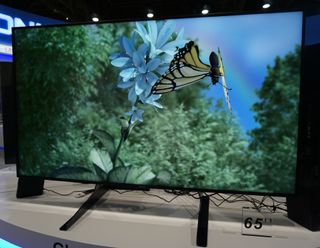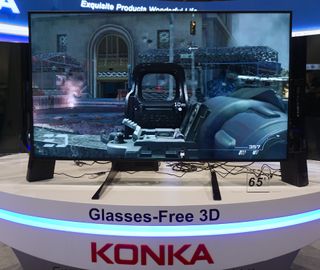Glasses-Free 3D Video Finally Works with Stream TV's Tech
Stream TV has found a clever way to produce convincing, hologram-like images and has signed on companies to make TVs with the technology.

LAS VEGAS — Cold fusion, perpetual motion and glasses-free 3D: One of these actually works now. At CES 2015, tech developer Stream TV Networks announced partners that will bring 3D technology to 4K consumer sets this year.
I gave these 4K 3D TVs a close look for glitches, but found only rare, minor issues that didn't hurt the experience. Like other 3D TVs, these models can also switch to a regular 2D mode, as well as upscale 2D content to 3D. (Of course you can't see the 3D effect in these 2D photos and videos I shot. But you can see that the process at least didn't hurt the image quality.)
Stream TV's glasses-free 3D technology isn't brand-new. I saw a very similar version of it at last year's CES. But the annual technology show is full of prototypes; graduating to a real product is newsworthy.
MORE: Hottest TVs for 2015
In 2015, 3D fans in China will be able to buy glasses-free models from Konka (which I got a chance to try out), Skyworth and Hisense; those in the U.K. will get models from Cello Electronics. Longtime 3D screen maker (and far from household name) Izon will be supplying the U.S.
However, Hisense currently sells TVs in the U.S., including its popular H4 Roku TV (see review). Pegatron, a back-end company that makes TVs for several sellers, will also be producing sets with Stream TV's technology, though it hasn't said yet for what brands.
Of course, it's a question of how many people will be clamoring to buy a new 3D set. While the 3D viewing experience has a few fans, it has so far, in some ways, shaped up to be the Zima beverage of technology — something boosters hope catches on, but that never does.
Sign up to get the BEST of Tom’s Guide direct to your inbox.
Upgrade your life with a daily dose of the biggest tech news, lifestyle hacks and our curated analysis. Be the first to know about cutting-edge gadgets and the hottest deals.
Pixel-splitting and faux holograms
It might take a degree in optical physics to totally understand what Stream TV is doing, but the gist is pretty clear, and clever. It takes advantage of the fact that pixels in most LCDs (and other displays) are made of three subpixels — red, green and blue. All TVs control each subpixel independently in order to create the right mix of these primary colors to create the right hue. But there's no law saying that a subpixel can work only with the ones immediately adjacent to it.

Stream TV's screens feature lenses that can direct the light coming off each subpixel at a unique angle, allowing the primary colors from different pixels to converge at a distance in front of the screen. The company uses 4K/ultra HD screens to provide enough resolution for a convincing image. The other part of Stream TV's technology is algorithms for driving the process.
To me, the effect looked a bit like a hologram — the nirvana of glasses-free 3D, but one that is still way too complex and expensive to implement.
Stream's effects are easy to see from multiple angles around the screen. I sat at both the middle and the end of a couch in front of a prototype, and walked a full arc around a 65-inch model from Konka, with no viewing trouble. The video had a slight wobbly look if I moved too far and too quickly to the side, but it stopped once I did.
The only other issue is that the individual pixels became obvious — looking like tiny orbs — when I got too close to the screen. With Konka's 65-inch set, I started seeing the orbs if I got closer than about 50 inches. But with a screen that big, that's not a big deal.
A future for 3D?

At its CES booth, Stream TV also showed off a prototype 10-inch tablet, which will be its next product to develop. With such a small screen, the tablet's 1080p resolution was plenty to create a convincing 3D effect. A representative from stream did tell me, however, that the company is beginning to deploy its tech on prototypes with 10-inch, 4K LCDs.
MORE: LG's UF9550 Nanocrystal TVs Rival OLEDs
Although glasses-free 3D tech finally works, it may not matter. Consumers didn't go gaga over 3D when it came to TVs years ago. Some A-list TV makers, such as Vizio, have dropped the technology from new sets; others, like Samsung, include it in higher-end models but often fail to mention it.

Aside from Hisense, the big TV makers are pushing for other advances, especially fuller color using quantum-dots and other technologies, as well as high dynamic range. Glasses-free 3D doesn't seem to be a priority, so it's unclear if many of us will ever get access to it — no matter how well it works.
- New Roku Smart TVs Coming: Haier, Insignia and TCL 4K
Best TVs You Can Buy Now - Best Streaming Players: Chromecast, Roku, Apple TV & More
Follow senior editor Sean Captain @seancaptain. Follow us @tomsguide, on Facebook and on Google+.
Sean Captain is a freelance technology and science writer, editor and photographer. At Tom's Guide, he has reviewed cameras, including most of Sony's Alpha A6000-series mirrorless cameras, as well as other photography-related content. He has also written for Fast Company, The New York Times, The Wall Street Journal, and Wired.
